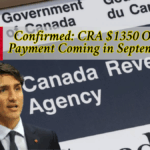Starting April 1, 2025, many Canadian workers will see a welcome boost to their hourly pay. Several provinces, along with federally regulated sectors, are increasing minimum wage rates as part of scheduled or inflation-indexed adjustments. These changes are aimed at helping workers keep pace with the cost of living, maintain purchasing power, and support household stability during a time of economic pressure. While some provinces have fixed new rates, others are still finalizing their adjustments for later in the year.

Pay Raise Alert! Canada’s Minimum Wage Rising
| Jurisdiction | Current Rate | New Rate (Effective Date) | Notes |
|---|---|---|---|
| Federal | $17.30 | $17.75 (April 1, 2025) | Applies to federally regulated sectors like banks, air transport, and telecommunications |
| Newfoundland & Labrador | $15.60 | $16.00 (April 1, 2025) | Adjustment tied to annual review; part of multi-year wage policy |
| Nova Scotia | $15.30 | $15.65 (April 1, 2025) | Adjusted using the Low-Income Cut-Off formula plus inflation |
| New Brunswick | $15.30 | $15.65 (April 1, 2025) | Annual indexed increase based on Consumer Price Index |
| Yukon | $17.59 | $17.94 (April 1, 2025) | Tied directly to inflation in Whitehorse |
| Nunavut | $19.00 | TBD | Still the highest rate in the country; next change pending |
| British Columbia | $17.40 | $17.85 (June 1, 2025) | Annual indexed increase to preserve worker purchasing power |
| Ontario | $17.20 | ~$17.70 (Expected Oct 1) | Projected increase based on Ontario’s CPI |
| Quebec | $15.75 | TBD (May 1, 2025) | Minimum wage review expected in spring |
| Manitoba | $15.80 | TBD (Oct 1, 2025) | Scheduled review pending final figures |
| Alberta | $15.00 | No change announced | Flat rate since 2018; no scheduled increases |
| Saskatchewan | $15.00 | TBD | Minimum wage expected to increase in October |
| Official Info Source | — | canada.ca – Minimum Wage Info | Official government source for national wage standards |
-
Federal and several provincial minimum wages increase starting April 1, 2025
-
Yukon and Nunavut continue to lead with the highest hourly rates
-
Ontario, BC, and Manitoba will implement changes later in the year
Federal Minimum Wage Details
Workers in federally regulated industries such as telecommunications, transportation, and banking will see their hourly minimum wage rise from $17.30 to $17.75 on April 1, 2025. The increase follows a standard CPI-based adjustment policy. Each year, the federal government reviews economic data and adjusts the minimum wage to help workers keep up with inflation. Employers in these sectors must apply the new rate regardless of the provincial minimum wage if it’s lower.
This update ensures wage consistency and fair treatment for employees working under federal labor jurisdiction across all provinces and territories.
Province-by-Province Breakdown
Newfoundland & Labrador
Minimum wage increases to $16.00 from $15.60. The province follows an annual review system aimed at aligning wages with economic conditions and labor market trends. The long-term plan includes incremental increases to bring minimum wage closer to a livable wage standard.
Nova Scotia
Nova Scotia is raising its minimum wage to $15.65, based on a formula that includes the Low-Income Cut-Off plus annual inflation. This predictable system ensures steady increases and provides clarity to employers and employees.
New Brunswick
New Brunswick matches Nova Scotia’s rate with an increase to $15.65. The wage is indexed to the CPI, providing a consistent and fair method to determine future increases. This helps address the rising cost of housing, transportation, and food.
Yukon
Yukon’s rate will move from $17.59 to $17.94, one of the highest in the country. The territory calculates adjustments using the Whitehorse CPI, directly linking wage growth to cost-of-living realities in the region. This method makes sure that wage earners can manage day-to-day expenses in Canada’s northern communities.
British Columbia
BC will increase its minimum wage to $17.85 on June 1, 2025. This follows the province’s annual routine of tying wage increases to inflation. The government aims to balance worker protection with business sustainability by setting changes at predictable intervals.
Ontario
While not yet finalized, Ontario is expected to raise its minimum wage to approximately $17.70 on October 1, 2025. This is based on the annual CPI review. Final figures are usually confirmed by the end of August. Ontario remains one of the few provinces with a regular, predictable increase policy that mirrors inflation.
Territories and Other Provinces
Nunavut continues to offer the highest minimum wage in the country at $19.00 per hour, with no confirmed change for 2025 yet. Its high rate reflects the extreme cost of goods and services in remote Arctic communities.
Quebec and Manitoba are preparing for their annual adjustments, typically set in May and October respectively. Saskatchewan is expected to increase its wage in October as well, but exact figures have not been announced. Alberta remains the only province without a scheduled increase. Its rate has stayed at $15.00 since 2018.
FAQ
Who decides minimum wage increases in Canada?
Each province and territory sets its own minimum wage policies. The federal government sets a separate rate for federally regulated industries. Most jurisdictions use inflation-indexed formulas or economic indicators to determine adjustments.
When do minimum wage increases take effect?
Most new rates begin on April 1, 2025. British Columbia’s will start June 1, Ontario’s in October, and other provinces like Quebec and Manitoba will confirm their changes closer to the implementation dates.
What if provincial and federal minimum wages differ?
Employees working in federally regulated industries must be paid the higher of the federal minimum wage or the provincial minimum wage where they are employed.
Are minimum wage jobs protected under labor law?
Yes, all minimum wage earners are protected under each jurisdiction’s labor standards. Employers are legally obligated to comply with posted rates and conditions, including overtime, holidays, and meal breaks.
Click here to know more



